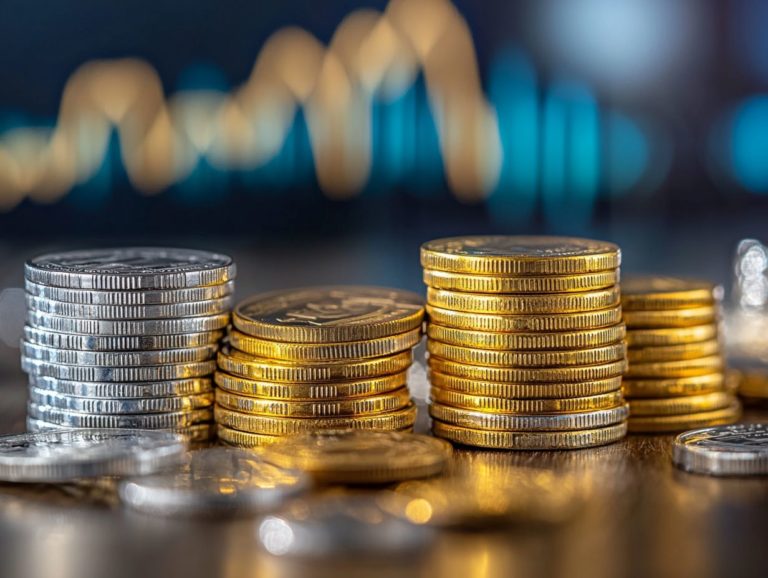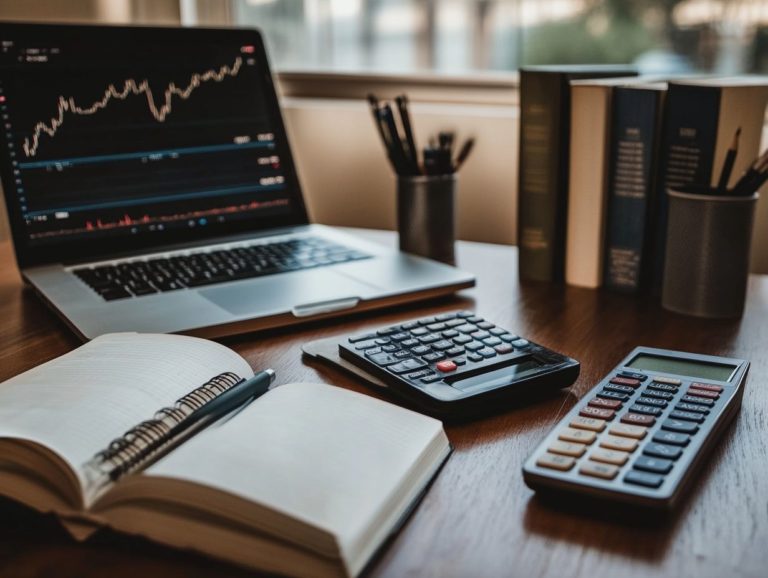Strategic Asset Allocation for Silver Investments
Silver has always held its ground as a valuable asset, admired not just for its industrial uses but also as a strategic investment choice.
This article delves into the benefits of investing in silver, highlighting its effectiveness as a diversification tool and a safeguard against inflation. It examines the factors that influence silver prices, the various investment avenues available, and best practices to optimize your returns.
Whether you’re a seasoned investor or new to the game, understanding silver’s potential can significantly elevate your financial portfolio.
Contents
- Key Takeaways:
- Benefits of Investing in Silver
- Factors Affecting Silver Prices
- Using a Smart Way to Invest in Silver
- Different Types of Silver Investments
- Best Practices for Silver Investing
- Frequently Asked Questions
- What is strategic asset allocation for silver?
- Why should I consider silver as part of my strategic asset allocation?
- How do I determine the appropriate amount of silver to include in my portfolio?
- What factors should I consider when making strategic asset allocation decisions for silver investments?
- Can I adjust my strategic asset allocation for silver investments over time?
- Are there any risks associated with including silver in my portfolio?
Key Takeaways:
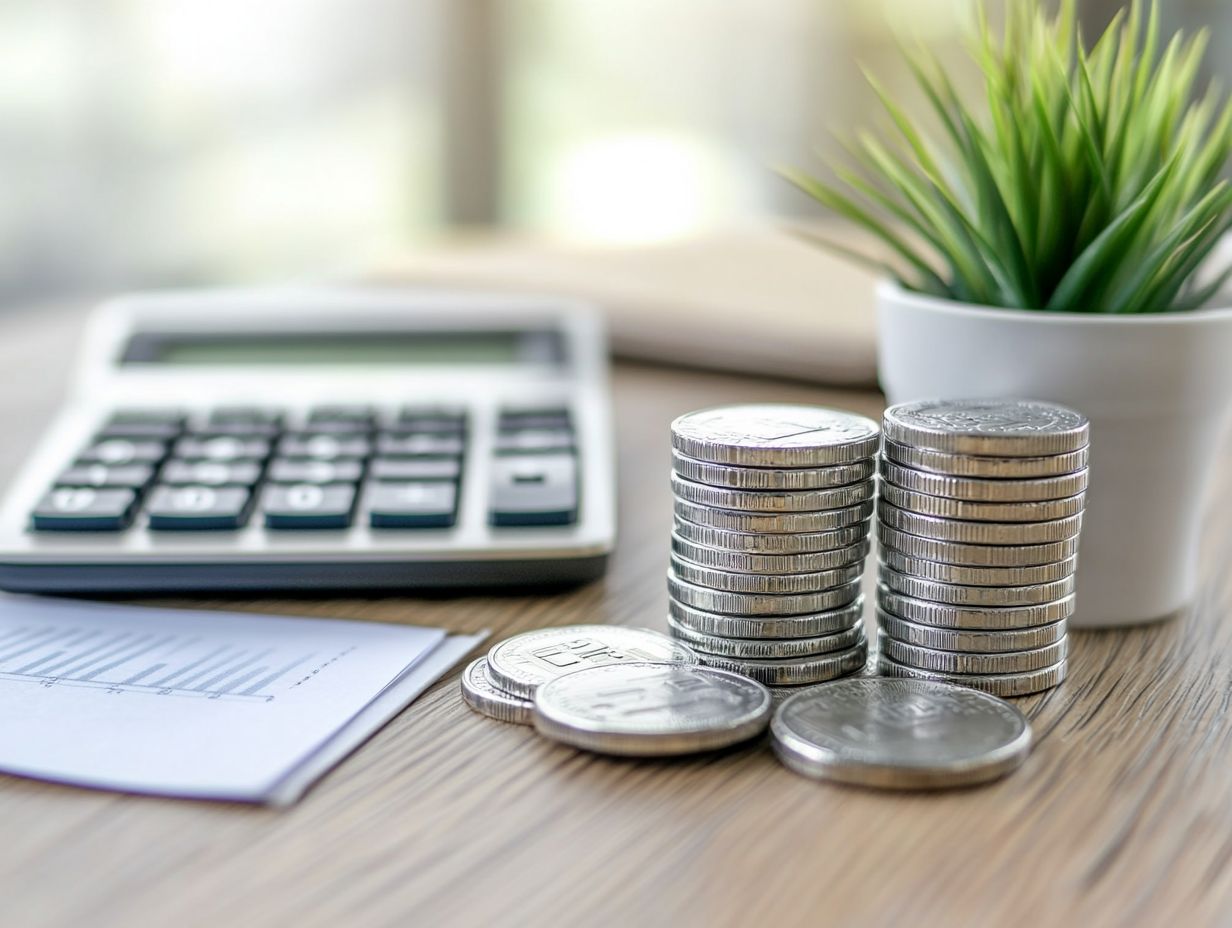
- Silver is a valuable metal that serves as a diversification tool and hedge against inflation in an investment portfolio.
- When considering strategic asset allocation for silver investments, carefully balance risk and allocate funds effectively based on market trends and demand.
- There are different types of silver investments to consider, including physical silver and paper silver, each with its own set of advantages and risks.
What is Silver?
Silver is a precious metal with a storied legacy, having served as a currency and a store of value for centuries. Its historical significance spans from ancient civilizations to contemporary financial markets.
Silver’s unique properties render it a versatile asset across various industries, including electronics and jewelry. It plays a critical role in economic reports, influencing market performance and investment strategies in the commodities sector.
This multifaceted nature draws many to silver. Its industrial applications range from photovoltaic cells in solar panels to antimicrobial coatings in medical devices. Unlike gold, which primarily serves as a wealth preservation asset, silver plays a dual role in finance and industry, greatly influencing its demand.
As an investor, you might find yourself analyzing silver’s market dynamics alongside gold. While silver exhibits greater volatility, it also presents the potential for substantial returns under certain economic conditions. This relationship underscores silver’s importance in creating diversified portfolios and highlights its integral role in the broader economic landscape.
Benefits of Investing in Silver
Investing in silver offers numerous advantages for those eager to enhance their portfolios and achieve a balanced asset allocation. This is especially crucial during periods of economic downturn and volatility.
Silver is not just a metal; it s your shield against inflation. It helps preserve your wealth and keeps your finances stable.
Diversification and Inflation Hedge
Diversification is a fundamental principle in investment strategy. Incorporating silver provides an effective hedge against inflation, enhancing your financial stability amid fluctuating market conditions.
By adding silver to your investment portfolio, you can mitigate risks associated with other asset classes, particularly during periods of economic uncertainty.
When examining the relationship between silver and traditional investments like gold, stocks, and bonds, it s clear that silver not only serves as a refuge but also presents unique liquidity benefits.
Historically, silver has shown remarkable resilience during inflationary periods, often outperforming other assets as consumer prices rise. Silver often moves independently from equities, making it a valuable component of a diversified strategy.
By balancing your portfolio with silver, you can adeptly navigate the complexities of the financial landscape while capitalizing on its potential for appreciation.
Are you ready to explore the incredible potential of silver? Start your investment journey today!
Factors Affecting Silver Prices
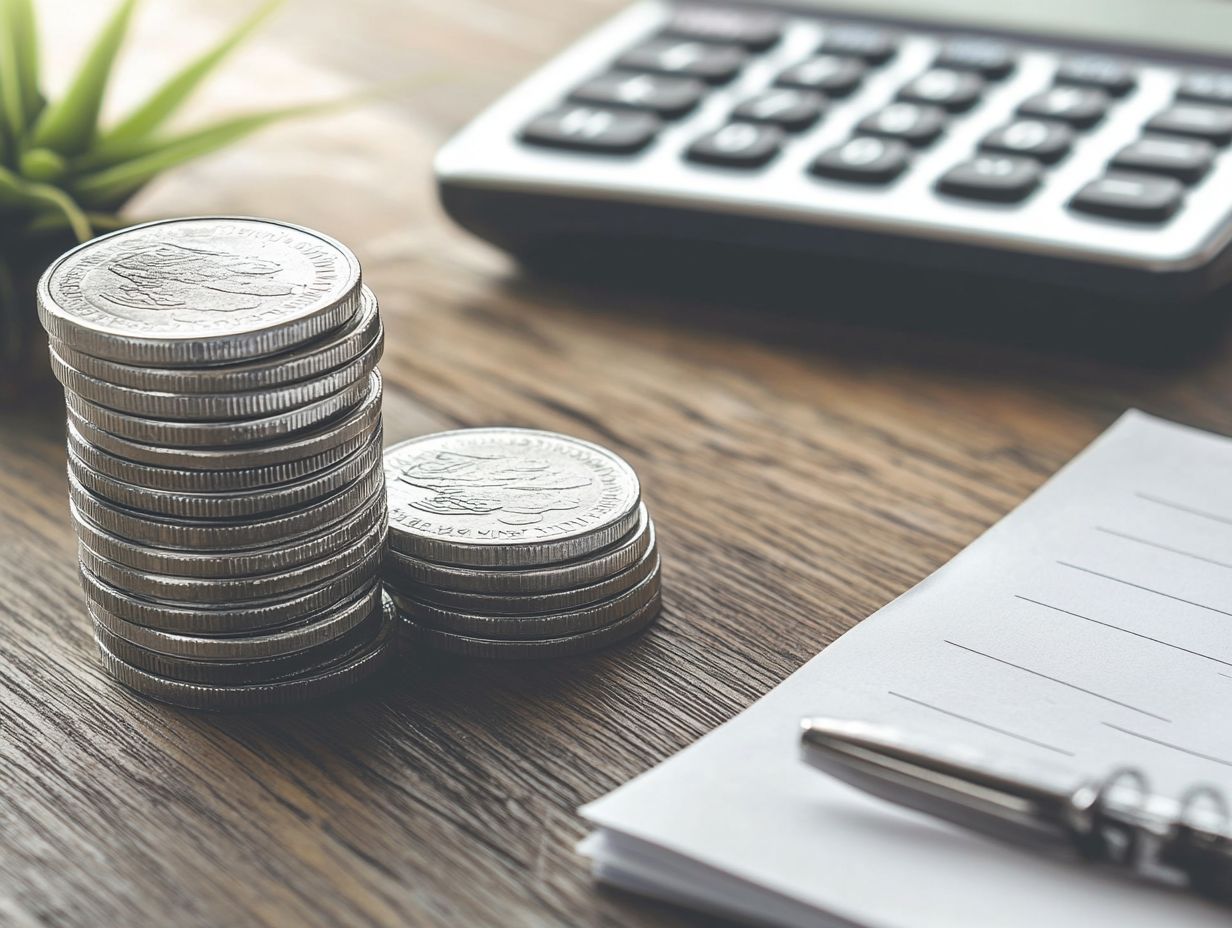
Several key factors influence silver prices, including market trends, demand, supply dynamics, and broader economic conditions.
Understanding these elements is essential for recognizing investment opportunities in the precious metals sector.
Economic reports and analyses frequently emphasize how shifts in industrial demand, geopolitical events, and inflationary pressures can trigger significant price movements in silver. It’s crucial to stay informed.
Market Trends and Demand
Market trends in silver are greatly shaped by both industrial demand and investment interest, significantly influencing its value within the broader economic landscape. Understanding these trends can help you seize investment opportunities.
As industries like clean energy and technology increasingly rely on silver for their production needs, grasping how these trends impact demand becomes essential for you as an investor seeking to capitalize on potential growth.
The rise in electric vehicle (EV) manufacturing, where silver plays a vital role in battery technology, has introduced a compelling dynamic to the market. Moreover, advancements in photovoltaic cells for solar energy have further amplified demand, leveraging silver s efficiency-boosting properties.
This duality, where silver is recognized as both an industrial necessity and a safe-haven investment, highlights the importance of keeping a keen eye on market shifts. With economic uncertainties on the horizon, discerning investors like you are paying closer attention to changes in industrial consumption and speculative purchases, striving to balance portfolios amidst evolving strategies in the commodities market.
Using a Smart Way to Invest in Silver
Using a smart way to invest in silver is crucial for optimizing your returns while maintaining a balanced risk profile within a diversified portfolio.
By thoughtfully allocating your funds to silver, you can enhance your exposure to precious metals, ensuring that your investment strategy aligns seamlessly with your broader financial stability goals and effective risk management practices.
Allocating Funds and Balancing Risk
Allocating your funds effectively while balancing risk is crucial for successful silver investing. It allows you to optimize your investment strategies and performance metrics. Understanding the risks involved in investing in silver is essential, and adjusting your allocations accordingly will help align with your investment objectives and market conditions.
By employing various risk management techniques, such as tools to protect your investment, you can safeguard your portfolio against market volatility and unforeseen fluctuations.
- Diversification across different assets,
- Utilizing hedging instruments,
- Establishing clear exit points.
These approaches can significantly enhance the resilience of your investments. By evaluating market conditions like demand-supply dynamics, economic indicators, and geopolitical influences act now to take advantage of these shifts before they change.
Integrating these factors into your silver allocation strategy not only simplifies the complexities of the market but also optimizes your returns while minimizing potential losses.
Different Types of Silver Investments

You have a range of silver investment options at your disposal, from tangible silver and bullion to paper silver alternatives, each presenting its own distinct advantages and risks.
Understanding the differences between these types is essential for you as an investor aiming to make informed decisions that align with your financial objectives and investment strategies.
Explore these silver investment options now to align with your financial goals.
Physical Silver vs. Paper Silver
When navigating the world of silver investment, you’ll often find yourself weighing the merits of physical silver against paper silver. Each offers unique advantages in liquidity, performance, and security.
Physical silver, such as bullion or coins, grants you physical possession. In contrast, paper silver simplifies trading and market access, sidestepping the complexities of storage.
In terms of liquidity, paper silver usually takes the lead. You can buy and sell it swiftly through various online platforms and exchanges, allowing you to realize gains with minimal wait time. Conversely, selling physical silver may require more effort.
Risk profiles also differ significantly. While physical silver is vulnerable to theft or damage, paper silver carries counterparty risks the risk of the other party not fulfilling their obligation linked to the financial institutions that issue it. Storage is also a crucial consideration if you choose physical holdings; secure storage solutions can add extra costs to your investment.
Market performance statistics reveal that physical silver has a strong track record of maintaining its value during economic downturns. Paper silver is usually tracked through derivatives and ETFs, which tend to respond more rapidly to market fluctuations, making it an appealing choice for those focused on short-term trading.
Best Practices for Silver Investing
Adopting best practices for silver investing is essential for maximizing your returns and effectively managing risks. This ensures you are well-prepared to navigate the intricacies of the silver market.
Key strategies include conducting thorough research, staying updated on market trends, and aligning your investment decisions with your long-term financial stability goals.
Tips for Maximizing Returns
Unlock your potential for greater returns on silver investments by implementing effective strategies today! This involves accounting for market volatility and economic downturns while keeping a close eye on performance metrics.
Dive deep into price movements and grasp market conditions to make informed decisions rooted in thorough research and forecasts.
By utilizing tools like technical analysis, which examines price movements, and charting techniques, which visualize these movements, you can pinpoint the best entry and exit points. This enables timely adjustments to your portfolio.
Stay informed about economic reports such as employment figures and inflation data for invaluable insights into the optimal times to buy or sell. Understanding global market trends and geopolitical factors is just as critical, as these elements can dramatically sway silver prices.
Stay ahead of the game by understanding how global trends can swing silver prices dramatically. Ultimately, being proactive and adaptable in response to market dynamics will empower you to enhance your potential returns and protect your investments from unexpected challenges.
Frequently Asked Questions
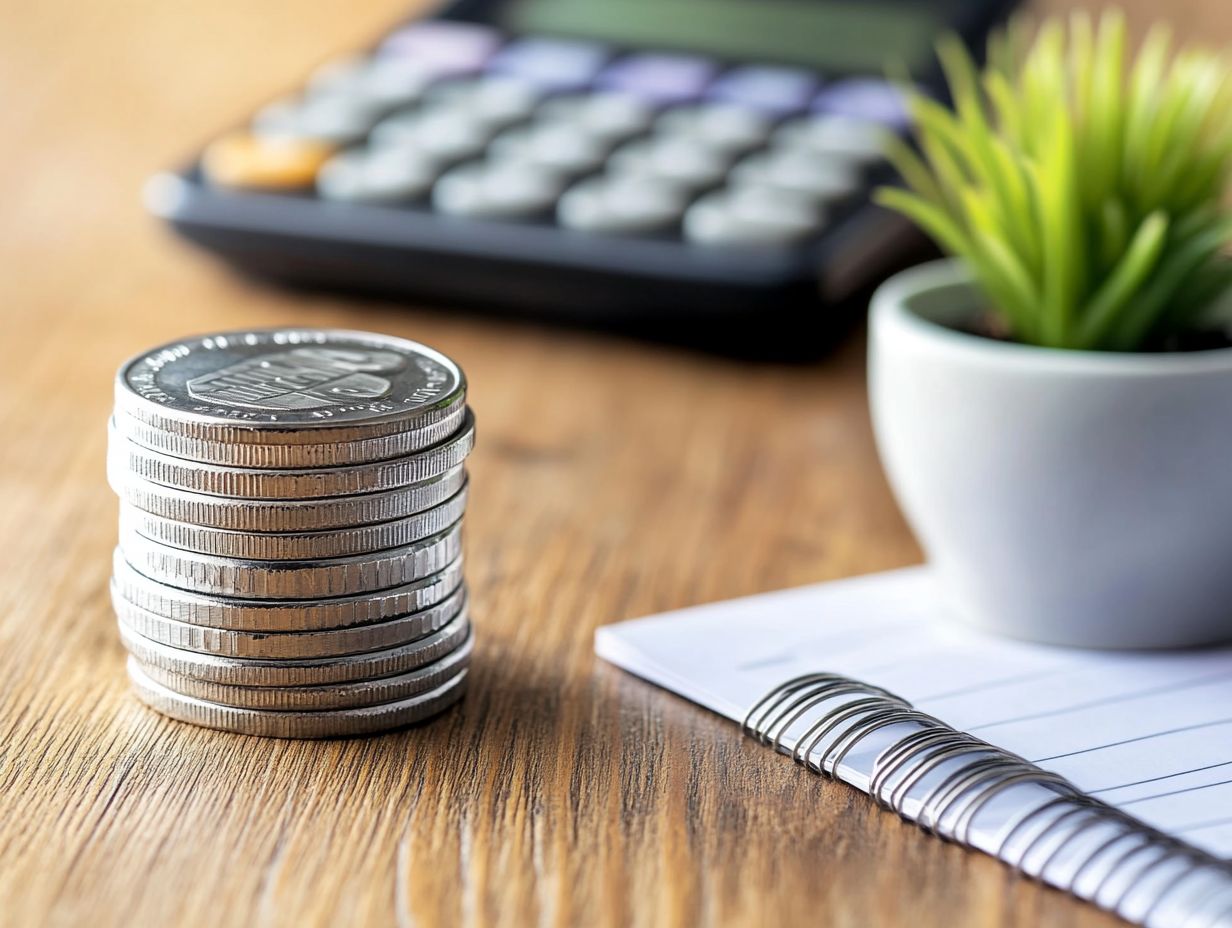
What is strategic asset allocation for silver?
Strategic asset allocation for silver investments is the process of determining the optimal mix of silver assets in an investment portfolio to achieve your desired long-term financial goals and manage risk.
Why should I consider silver as part of my strategic asset allocation?
Silver has historically been a valuable asset with a low correlation to other asset classes, making it a strong diversifier in a portfolio. It can also serve as a hedge against inflation and financial market volatility.
How do I determine the appropriate amount of silver to include in my portfolio?
The right amount of silver depends on your personal financial goals and risk tolerance. Consult a financial advisor to tailor your allocation.
What factors should I consider when making strategic asset allocation decisions for silver investments?
Important factors include current market conditions, global economic trends, inflation rates, and the overall performance and volatility of silver as an asset.
Can I adjust my strategic asset allocation for silver investments over time?
Yes, you should regularly review your asset allocation. Adjust it as your financial goals and market conditions change.
Are there any risks associated with including silver in my portfolio?
Yes, silver investments come with risks like market volatility and price fluctuations. It’s crucial to diversify your investments and think carefully about your overall strategy.











